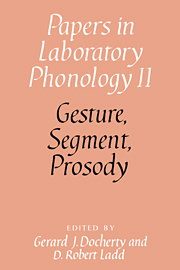Book contents
- Frontmatter
- Contents
- List of contributors
- Acknowledgments
- Introduction
- Section A Gesture
- Section B Segment
- Section C Prosody
- 13 An introduction to intonational phonology
- 14 Downstep in Dutch: implications for a model
- 15 Modeling syntactic effects on downstep in Japanese
- 16 Secondary stress: evidence from Modern Greek
- Appendix 1 The test phrases (bold type) of experiment 1 in the context in which they were read
- Appendix 2 The distractors (bold type) of experiment 1 in the context in which they were read
- Appendix 3 The test sentences of experiment 2. The test words are in bold type
- Appendix 4 The distractor sentences of experiment 2. The distractors are in bold type
- References
- Name index
- Subject index
15 - Modeling syntactic effects on downstep in Japanese
from Section C - Prosody
Published online by Cambridge University Press: 18 December 2009
- Frontmatter
- Contents
- List of contributors
- Acknowledgments
- Introduction
- Section A Gesture
- Section B Segment
- Section C Prosody
- 13 An introduction to intonational phonology
- 14 Downstep in Dutch: implications for a model
- 15 Modeling syntactic effects on downstep in Japanese
- 16 Secondary stress: evidence from Modern Greek
- Appendix 1 The test phrases (bold type) of experiment 1 in the context in which they were read
- Appendix 2 The distractors (bold type) of experiment 1 in the context in which they were read
- Appendix 3 The test sentences of experiment 2. The test words are in bold type
- Appendix 4 The distractor sentences of experiment 2. The distractors are in bold type
- References
- Name index
- Subject index
Summary
Introduction
One of the most significant findings about Japanese intonation in the past decade or so has been the existence of downstep. At least since the 1960s, the most widely accepted view had been that pitch downtrend is essentially a phonetic process which occurs as a function of time, more or less independently of the linguistic structure of utterances (see e.g. Fujisaki and Sudo 1971a). Against this view, Poser (1984) showed that downtrend in Japanese is primarily due to a downward pitch register shift (“catathesis” or “downstep”), which is triggered by (lexically given) accents of minor intonational phrases, and which occurs iteratively within the larger domain of the so-called major phrase. The validity of this phonological account of downtrend has subsequently been confirmed by Beckman and Pierrehumbert (Beckman and Pierrehumbert 1986; Pierrehumbert and Beckman 1988) and myself (Kubozono 1988a, 1989).
Consider first the pair of examples in (1).
uma'i nomi'mono “tasty drink”
nomi'mono “sweet drink”
The phrase in (la) consists of two lexically accented words while (lb) consists of an unaccented word (of which Tokyo Japanese has many) and an accented word. Downstep in Japanese looks like figures 15.1a and 15.2 (solid line), where an accented phrase causes the lowering of pitch register for subsequent phrases, accented and unaccented alike, in comparison with the sequences in which the first phrase is unaccented (i.e. figures 15.1b and 15.2, dotted line).
- Type
- Chapter
- Information
- Gesture, Segment, Prosody , pp. 368 - 397Publisher: Cambridge University PressPrint publication year: 1992
- 28
- Cited by



